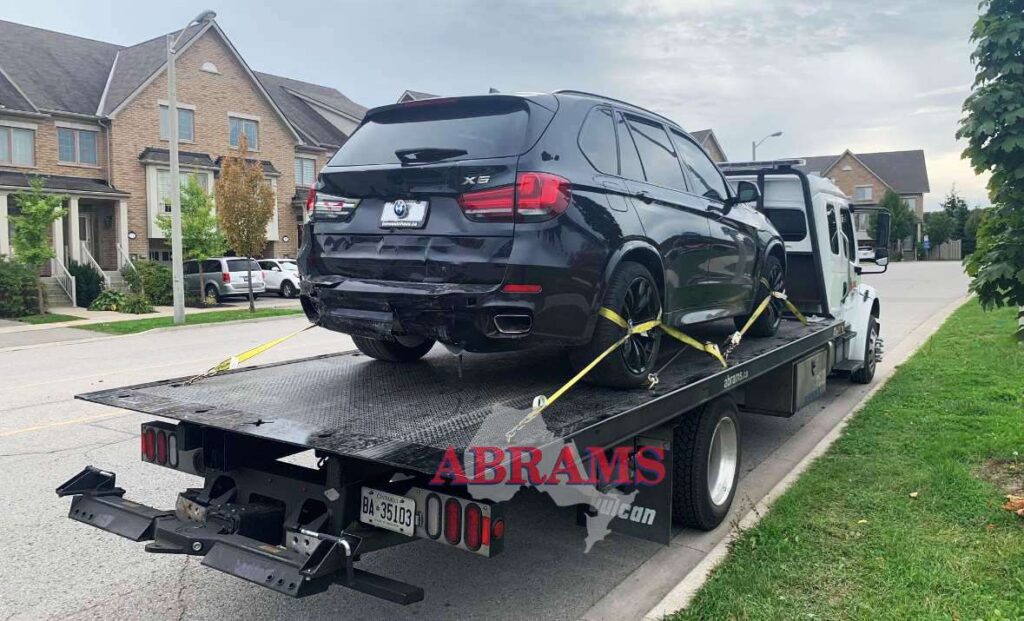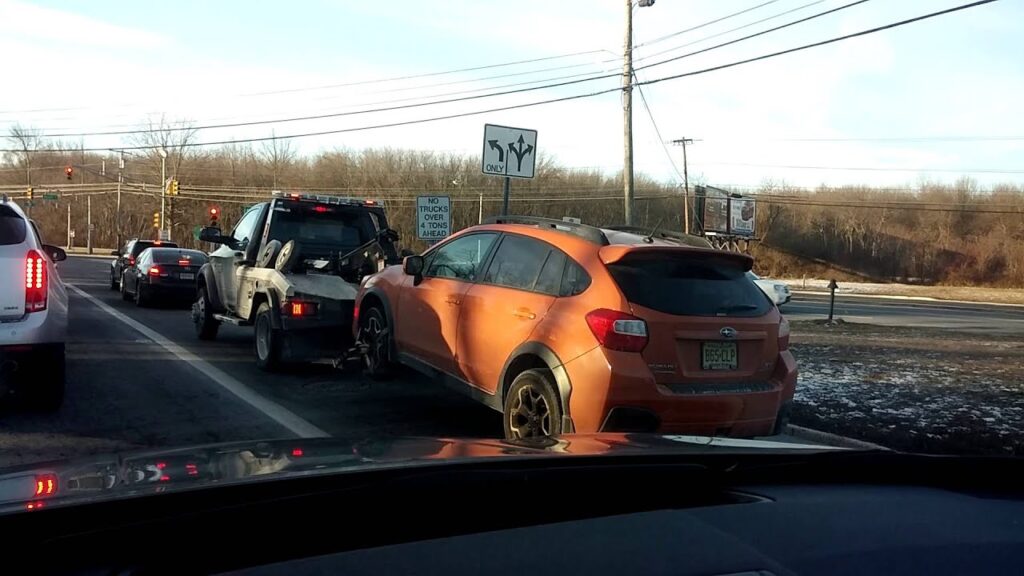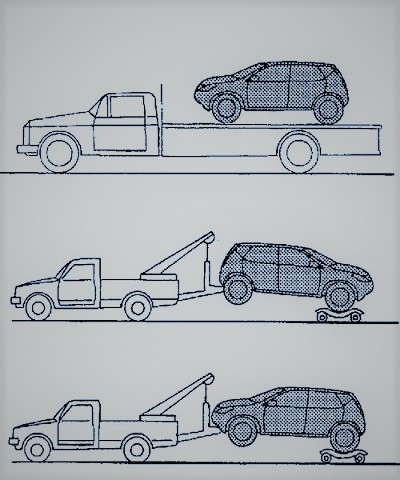Towing an all-wheel drive (AWD) car can be a delicate task that requires careful attention and proper technique. Whether you find yourself in a situation where you need to move your AWD vehicle or are simply curious about the process, understanding the intricacies of towing an AWD car is essential. From selecting the right tow truck to using the appropriate equipment, this article provides valuable insights into the safe and efficient towing of AWD vehicles.

This image is property of greentowing-losangeles.com.
Preparing for Towing
Preparing an all-wheel drive (AWD) car for towing requires careful attention to detail and following specific steps to ensure the safety and integrity of the vehicle. Before you begin towing, there are several important considerations to keep in mind.
Check the Owner’s Manual for Specific Instructions
The first step in preparing to tow an AWD car is to consult the owner’s manual. Each vehicle may have unique towing instructions, weight limits, and precautions. It is crucial to familiarize yourself with these guidelines to prevent any damage to the AWD system or other components.
Choose the Right Tow Truck or Dolly
Selecting the appropriate tow truck or dolly is essential for towing an AWD car safely. Flatbed towing is generally the preferred method for AWD vehicles since all wheels are off the ground, minimizing the risk of damage to the drivetrain. However, if a flatbed truck is not available, there are other towing methods available, such as tow dollies or four-wheel dollies. It is crucial to choose a method that aligns with the owner’s manual recommendations.
Inspect the AWD System
Prior to towing, it is important to inspect the AWD system for any signs of damage or wear. Check for any leaks, unusual noises, or vibrations. If you notice any issues, it is advisable to have the vehicle inspected by a professional before proceeding with towing. Ensuring the AWD system is in good condition is crucial for a successful and damage-free towing experience.
Secure All Loose Items
Before towing an AWD car, it is vital to secure all loose items inside the vehicle. Remove any personal belongings, tools, or loose objects that could shift and cause damage during transportation. Secure the car’s windows and doors to prevent any items from falling out or causing damage to the vehicle or other vehicles on the road during towing.
Towing Methods for AWD Cars
There are several methods available for towing an AWD car, each with its own considerations and benefits. Understanding these methods will help you choose the most suitable option for your specific situation.
Flatbed Towing
Flatbed towing is widely regarded as the safest method for towing AWD vehicles. It involves loading the entire AWD car onto a flatbed truck, ensuring that all wheels are off the ground. By keeping the car level and evenly distributing the weight, flatbed towing minimizes stress on the AWD system and reduces the risk of damage during transportation.
Tow Dolly Towing
Tow dolly towing involves using a two-wheeled trailer that lifts the front wheels of the AWD car off the ground while leaving the rear wheels in contact with the road. This method is suitable for shorter distances or when a flatbed truck is not available. However, it is important to note that tow dolly towing may place additional stress on the AWD system, as the rear wheels are still in contact with the ground.
All-Wheel or Four-Wheel Dolly Towing
All-wheel or four-wheel dolly towing involves using a specialized trailer with two additional wheels that are capable of supporting all four wheels of the AWD car. This method evenly distributes the weight and provides additional stability during towing. However, it may not be suitable for all AWD cars, as some vehicles may have restrictions on towing methods.
Two-Wheel Dolly Towing
In certain situations, two-wheel dolly towing may be an option for towing an AWD car. This method involves lifting either the front or rear wheels of the vehicle off the ground using a tow dolly. However, it is important to consult the owner’s manual and ensure that this method is compatible with the specific AWD car being towed.

This image is property of www.abrams.ca.
Preparing the AWD Car for Towing
Properly preparing the AWD car for towing is crucial to minimize the risk of damage and ensure a smooth transportation process. Following these steps will help ensure the safety and integrity of the vehicle during towing.
Make Sure the AWD System is Disengaged
Before attaching the tow truck or dolly, it is essential to disengage the AWD system according to the owner’s manual instructions. Failure to do so could cause significant damage to the drivetrain during towing. Ensure that the AWD system is properly disengaged to avoid any unnecessary strain on the vehicle’s components.
Release the Parking Brake
To prevent any damage to the AWD car’s brakes or drivetrain, it is important to release the parking brake before towing. Leaving the parking brake engaged during towing can result in excessive heat generation and potential damage to the vehicle’s braking system. Double-check that the parking brake is fully released before proceeding with towing.
Disable the Steering Lock
Many AWD cars have a steering lock mechanism that engages when the ignition is off. Before towing, ensure that the steering lock is disabled according to the owner’s manual instructions. Failure to disable the steering lock may cause damage to the vehicle’s steering components when the wheels are turned during transportation.
Secure the Wheels
To further protect the AWD car during towing, it is crucial to secure the wheels properly. Use wheel straps or other suitable tie-down methods to ensure that the wheels do not move or rotate while being towed. This will prevent unnecessary stress on the drivetrain and suspension components, reducing the risk of damage during transportation.
Attaching the Tow Truck or Dolly
Properly attaching the tow truck or dolly to the AWD car is essential for safe and secure transportation. Following these steps will help ensure that the connection is strong and reliable.
Connect the Tow Straps or Chains
Attach the tow straps or chains to the designated towing points on the AWD car. Refer to the owner’s manual for the specific locations of these towing points. It is important to use straps or chains that are rated for the weight of the AWD car and ensure that they are properly connected and secure.
Ensure Proper Alignment
Before towing, ensure that the tow truck or dolly is properly aligned with the AWD car. Misalignment may cause excessive stress on the drivetrain or suspension, potentially resulting in damage during transportation. Confirm that the tow truck or dolly is aligned straight and centered with the AWD car for a secure attachment.
Attach the Safety Chains
In addition to the tow straps or chains, it is important to attach safety chains as an extra layer of security. Cross the safety chains under the AWD car’s frame, ensuring they are securely connected to the tow truck or dolly. The safety chains provide additional support in the event of a tow strap or chain failure.
Secure the AWD Car to the Tow Truck or Dolly
Double-check that the AWD car is securely and tightly attached to the tow truck or dolly before beginning towing. Ensure that all connections are properly tightened, and there is no excessive movement or play. Tug on the AWD car gently to confirm that it is well-secured before proceeding with towing.

This image is property of www.abrams.ca.
Towing the AWD Car
When towing an AWD car, it is essential to follow certain precautions and guidelines to ensure a safe and smooth towing experience. By keeping these factors in mind, you can minimize the risk of damage and make the towing process as seamless as possible.
Maintain a Safe Speed
When towing an AWD car, it is crucial to maintain a safe and moderate speed. Avoid excessive speeds, as they can increase the risk of accidents or cause additional strain on the AWD system. Adhere to all traffic laws and regulations, and stay within the recommended speed limits for towing.
Avoid Sharp Turns
To safeguard the AWD car during towing, it is important to avoid sharp turns whenever possible. Sharp turns can place significant stress on the drivetrain and suspension components, potentially leading to damage. Take wider turns and plan your route accordingly to minimize the need for sharp maneuvers.
Be Cautious with Braking
Braking while towing an AWD car requires extra caution to ensure the safety of both vehicles involved. Allow for increased braking distances and apply the brakes gradually and evenly. Sudden or harsh braking can cause instability and potentially damage the AWD car’s components.
Regularly Check the AWD Car during Towing
During the towing process, make it a habit to regularly check the AWD car for any signs of issues or damage. Keep an eye out for fluid leaks, unusual noises, vibrations, or other abnormalities. If you notice anything out of the ordinary, safely pull over and inspect the AWD car before continuing.
After Towing the AWD Car
After successfully towing an AWD car, it is important to perform certain checks and procedures to ensure its post-towing condition meets the expected standards. Following these steps will help evaluate any potential damage and address any immediate concerns.
Inspect the AWD Car
Thoroughly inspect the AWD car after towing to identify any signs of damage or issues. Check for any physical damage, fluid leaks, loose connections, or irregularities. Pay close attention to the areas where the tow straps or chains were attached to ensure that no damage occurred during towing.
Re-engage the AWD System
If you disengaged the AWD system before towing, be sure to re-engage it according to the owner’s manual instructions. Failing to properly re-engage the AWD system may result in driving limitations or damage to the drivetrain. Follow the recommended procedure to ensure the AWD system is fully functional.
Check for Fluid Leaks
Inspect the AWD car for any fluid leaks. Fluid leaks can indicate damage to the vehicle’s transmission, engine, or other vital components. It is important to address any leaks promptly to prevent further damage and potential breakdowns. If you notice any leaks, it is advisable to consult a professional mechanic.
Test Drive the AWD Car
Before resuming regular use of the AWD car, take it for a brief test drive to ensure that everything is functioning properly. Pay attention to the vehicle’s responsiveness, steering, braking, and overall performance. If you detect any abnormalities, consult a qualified technician to address any concerns and perform further inspections if necessary.

This image is property of i.ytimg.com.
Signs of AWD System Damage during Towing
While towing an AWD car, it is important to be aware of signs that may indicate damage to the AWD system. Recognizing these signs early can help prevent further damage and potential costly repairs. If you notice any of the following signs, it is recommended to seek professional assistance:
Vibration or Noise
Excessive vibrations or unusual noises coming from the AWD car during towing could indicate damage to the drivetrain or suspension components. If you experience any vibrations or noises that seem out of the ordinary, it is recommended to have the vehicle inspected by a qualified technician.
Loss of Power
A noticeable loss of power or decreased performance while towing may suggest a problem with the AWD system. If the AWD car struggles to accelerate or exhibits a lack of power, it is advisable to consult a professional mechanic for a thorough diagnosis.
Unusual Fluid Leaks
Fluid leaks, such as oil or transmission fluid, can be a sign of damage to the AWD system. If you notice any fluid leaks during or after towing, it is crucial to have the AWD car inspected promptly. Ignoring fluid leaks can lead to further damage and potentially costly repairs.
Difficulty in Shifting Gears
If you experience difficulty in shifting gears while towing an AWD car, it may indicate an issue with the transmission or the AWD system. Delayed or rough gear shifts could be a sign of damage or misalignment. Seek professional assistance to diagnose and address any transmission or AWD system issues.
Seeking Professional Assistance
While towing an AWD car, there may be situations where seeking professional assistance becomes necessary. Whether you are uncertain about the towing process or experience any issues or damage, it is important to know when to consult experts in the field.
When in Doubt
If you have any doubts or questions about towing an AWD car, it is advisable to seek guidance from professionals. They can provide specific advice based on the make and model of your AWD car and ensure that you adhere to the manufacturer’s recommendations.
In Case of Damage or Issues
If you encounter any damage or issues during or after towing, it is essential to contact a professional mechanic or towing service. They have the expertise and equipment to diagnose and repair any damage to the AWD system or other components.
If the AWD Car cannot be Moved
In the event that your AWD car cannot be moved, it is recommended to call a reputable towing service. Attempting to tow a stationary or immobilized AWD car without proper knowledge and equipment may cause further damage. Professional towing services have the necessary tools and expertise to safely transport a non-functional AWD car.

This image is property of i.ytimg.com.
Conclusion
Towing an AWD car requires careful preparation, adherence to specific steps, and an understanding of the towing methods available. By following the guidelines outlined in this article, you can ensure that the towing process is conducted safely and without causing damage to the AWD system or other components. Remember to consult the owner’s manual for specific instructions, take necessary precautions, and seek professional assistance when needed. Properly towing an AWD car will help protect your vehicle and ensure a successful transportation experience.
